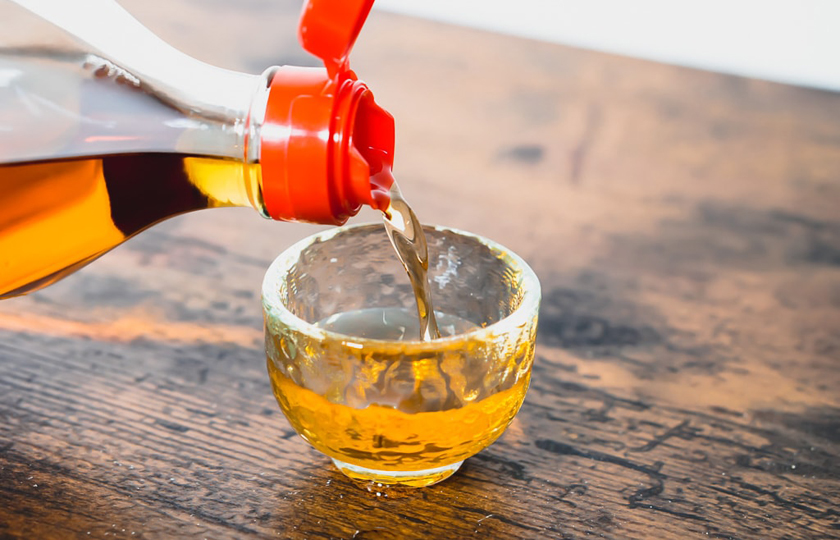What Is a Replacement for Mirin? Best Substitutes from Your Kitchen

Mirin is a soul seasoning in Japanese cuisine. However, when we find that we don't have mirin at home during cooking, we can't help but wonder: what on earth can replace it?
What Seasoning is Mirin?
Mirin (みりん) is an "invisible hero" in Japanese cuisine. Its brewing process is related to that of sake: steamed glutinous rice, koji (a fermenting agent rich in enzymes), and shochu (or sake) are mixed and left to ferment in an earthenware jar for 6 - 12 months.
In the final product, 14% - 20% alcohol and 40% - 50% sugar (mainly glucose) jointly form its flavor framework.
In Japanese cuisine, it has three important functions:
Lock in moisture: Brush a layer on grilled fish, making the skin crispy and the inside juicy.
Neutralize saltiness: Balance the sharpness of soy sauce and make the oden soup base more mellow.
Enhance luster: Most of the credit for the attractive caramel color of the teriyaki sauce clinging to ingredients goes to it.
Mirin Substitutes
In case of an emergency, remember the three key elements of mirin - "sweetness + wine aroma + viscosity" - to find solutions:
① Sake + Granulated Sugar (closest to the original)
Combine 1 tablespoon of sake with ½ teaspoon of white granulated sugar to restore about 80% of the flavor. The rice aroma of sake is similar to that of mirin, and the granulated sugar makes up for the sweetness. This is suitable for scenarios like teriyaki sauce and simmered dishes that require a prominent wine aroma.
② Rice Wine + Honey (Chinese - style improved version)
Use 1 tablespoon of rice wine plus 1 teaspoon of honey. The sweetness is more intense and has a floral and fruity aroma. It's particularly suitable for marinating teriyaki chicken wings. The honey will form an attractive caramelized crust during roasting.
③ Apple Juice + Lemon Juice (alcohol - free option)
Take 1 tablespoon of apple juice and ¼ teaspoon of lemon juice. The natural fruit acids can mimic the roundness of mirin. This is suitable for seasoning tamagoyaki for children's meals or for those who avoid alcohol. But be careful to control the heat to avoid over - acidity.
④ White Wine + Brown Sugar (Western - style creative version)
Combine 1 tablespoon of dry white wine with ¾ teaspoon of brown sugar. The light - bodied wine is suitable for seafood dishes. I once used it to make "Japanese - style white wine mussels" and unexpectedly received rave reviews from my fans!
Can I Substitute Mirin for Rice Vinegar?
Although both are Japanese seasonings, they are like coffee and tea - they can quench your thirst but can't substitute for each other.
Using mirin to substitute for rice vinegar:
The sweetness will overwhelm the refreshing sourness. When making sushi rice, it will make the rice sticky. If you really need to use it in an emergency, it is recommended to add 1 teaspoon of lemon juice to 1 tablespoon of mirin to balance the flavor.
Using rice vinegar to substitute for mirin:
Direct substitution will turn the teriyaki sauce into an "acidy - teriyaki sauce"! I tried making teriyaki chicken with rice vinegar last year. The finished product was so sour that even my neighbor's cat walked around it... The remedy is to add 1 tablespoon of sugar and ½ teaspoon of cooking wine to 1 tablespoon of rice vinegar.
Exceptional case: When making nanbanzuke (Japanese sweet - and - sour pickled fish), the two can be substituted 1:1, but you need to add extra ginger juice to remove the fishy smell.

How to Use Mirin?
The uses of mirin are far more than just being a "teriyaki sauce partner". The following scenarios can help you make the most of it:
① Classic uses
Teriyaki sauce: Combine mirin, soy sauce, and sugar in a ratio of 1:1:1. Simmer over low heat until thick and brush on chicken thighs and roast until caramelized.
Unagi sauce: Combine mirin, soy sauce, sake, and sugar in a ratio of 2:1:1:1. Boil and pour over grilled eel, then sprinkle with sansho powder.
Enhance flavor in stews: Add mirin to oden or beef stew pots. It can neutralize the astringency of radishes and make the soup more mellow.
② Hidden uses
Prevent fish from breaking: Add mirin when marinating salmon. The alcohol and sugar can inhibit the decomposition of muscle fibers, making the fish less likely to fall apart when frying.
Quick marinating of meat: Mix mirin and soy sauce in a ratio of 1:1. Marinate chicken breast for 10 minutes, and the meat will be more tender and smooth after frying.
Replace honey: Use mirin instead of honey in roasted chicken wings or char siu. It can color the food and prevent over - caramelization.
How to Store Mirin?
Don't be deceived by its high sugar content! Last year, my unrefrigerated bottle of mirin actually grew "snowflakes". These key points are summarized from this bitter lesson:
When unopened: Place it in the coolest corner of the cabinet (away from the stove!). The shelf life can reach 3 years. A little - known fact: the dark brown color of the mirin bottle is actually a UV - protection design.
After opening: It must be refrigerated (0 - 4°C) and used up within 3 months.
Lazy - person's solution: Tighten the original cap, wrap it with 2 layers of plastic wrap, and store it upright inside the refrigerator door.
Signs of spoilage: Appearance of flocculent substances and a smell like expired honey.
Substitute for Mirin in Teriyaki Sauce
① Homemade Simple Teriyaki Sauce
Recipe: 3 tablespoons of rice wine + 1 tablespoon of brown sugar + 1 tablespoon of soy sauce + 1 teaspoon of honey
Steps:
Pour the rice wine and brown sugar into the pot and simmer over low heat until the sugar melts (avoid boiling to prevent alcohol from evaporating too quickly);
Add soy sauce and honey and stir until thick (about 5 minutes). Keep stirring during this period to prevent the bottom from burning.
② Alcohol - Free Teriyaki Sauce
Recipe: 2 tablespoons of apple juice + 1 tablespoon of brown sugar + 1 tablespoon of soy sauce + ½ teaspoon of lemon juice
Principle:
The fructose in apple juice and the acidity of lemon juice mimic the sweet - and - sour balance of mirin;
Suitable for children or those allergic to alcohol, but the flavor may be a bit less complex.
Differences between Mirin and Cooking Wine
① Comparison of ingredients and flavors
Mirin:
Key ingredients: Glutinous rice, koji, shochu (high sugar, low salt);
Flavor: Dominated by sweetness, with a long - lasting wine aroma and an obvious caramelization reaction.
Cooking wine (taking Chinese cooking wine as an example):
Key ingredients: Yellow rice wine, salt, spices (such as Chinese prickly ash, star anise);
Flavor: Salty - umami flavor is prominent, with a relatively low alcohol content (10% - 15%) and a strong fishy - odor removal effect.
② Substitution misunderstandings and correct methods
Wrong example: Directly using cooking wine to replace mirin may result in a "disastrous dish" that is too salty and lacks sweetness.
Substitution formula:
If you need to use cooking wine to replace mirin, you need to add extra sugar (for example, 1 tablespoon of cooking wine + 1 teaspoon of sugar);
Conversely, if you use mirin to replace cooking wine, you need to reduce the amount of soy sauce (for example, 1 tablespoon of mirin + half a tablespoon of soy sauce).























